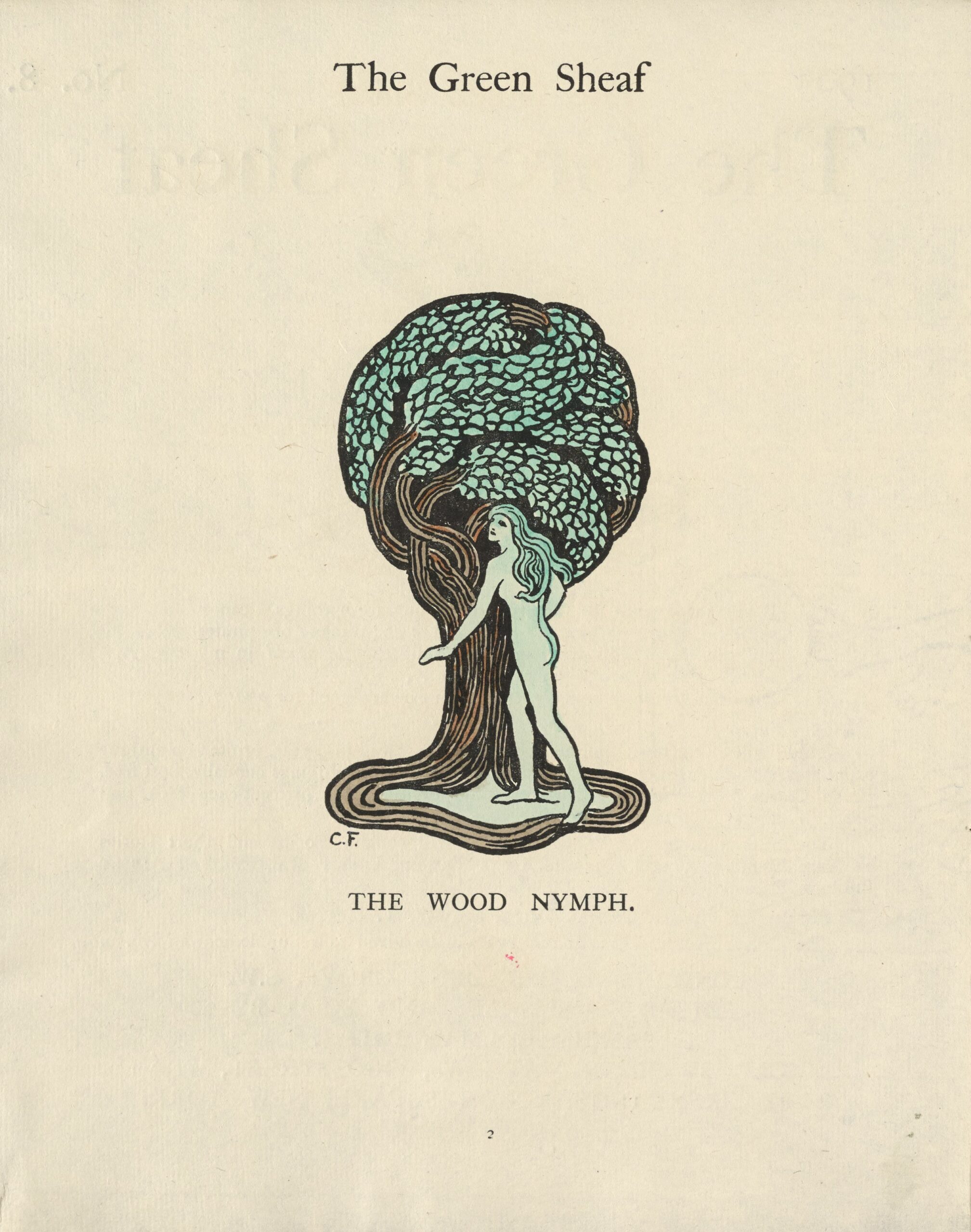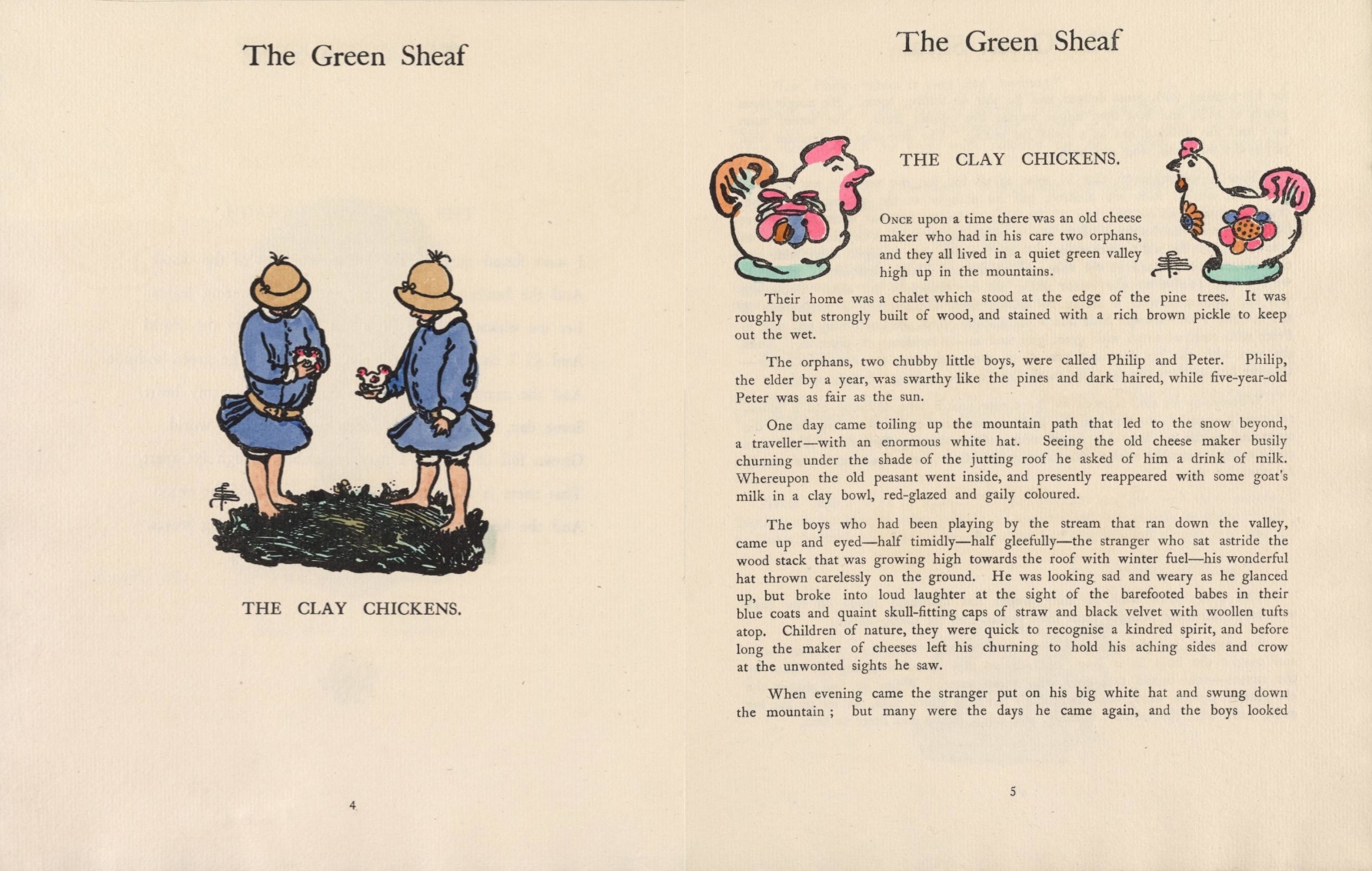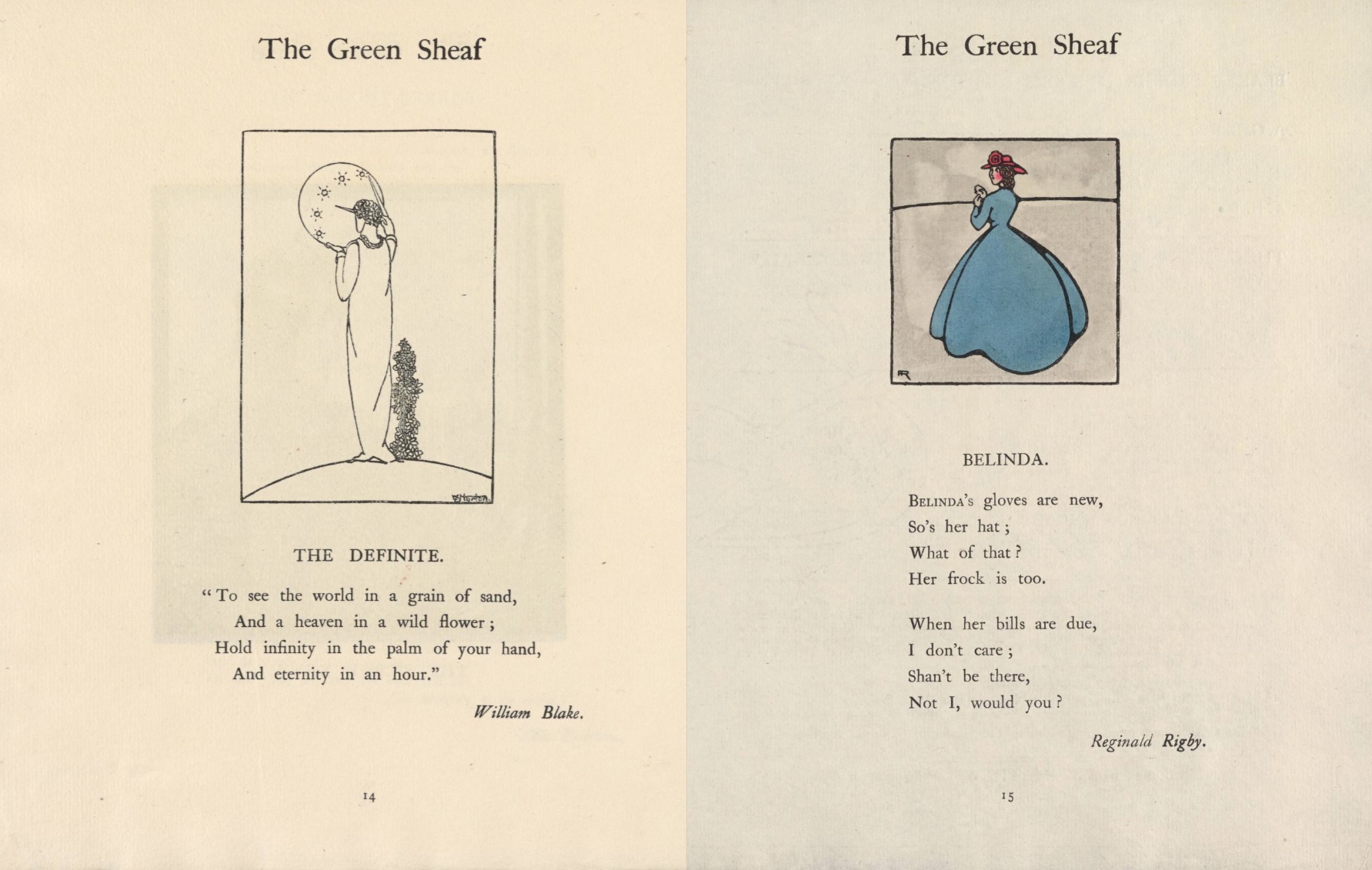XML PDF
Critical Introduction to The Green Sheaf
No. 8, 1903

The themes of the December number of The Green Sheaf are as diverse as its contents, and Pamela Colman Smith (1878-1951) conveys this eclecticism in her most variously hued colour palette to date (fig. 1). The magazine’s eighth issue glows with hand-coloured illustrations and textual decorations throughout its sixteen pages. Most of the images are by Smith herself, but returning artists Cecil French (1879-1953) and W.T. Horton (1864-1919), together with newcomer Reginald Rigby (1881-1943), contribute an illustration apiece. As he had done previously in The Green Sheaf, No. 2 (Untitled, 2), Horton once again illustrates an excerpt from William Blake (1757-1827). French and Rigby supply their own accompanying verses. Other first-time contributors are Francis Annesley (1884-1914), an Anglo-Irish peer, and Victor Bridges (1878-1972), a prolific English writer. Returning poets include L.C. Duncombe (1866-1947) and Alix Egerton (1870-1932) as well as Smith herself, bringing the total number of poems in the issue to eight. Two prose works by previous contributors complete the number. E. Harcourt Williams (1889-1957), an actor, producer, and director whom Smith knew through her ties to the London theatrical community, offers a sentimental story about orphans suitable for the Christmas season. In contrast to this homely tale, Smith’s friend Christopher St. John (aka Christabel Marshall, 1871-1960) gives a lurid account of a violent and macabre dream about Napoleon.

Smith gives the issue’s foremost position to frequent contributor Cecil French. The first opening features his full-page illustration “The Wood Nymph” on the verso and his accompanying poem, “The Wood of Laragh,” on the recto. Coloured in aquamarine and brown hues, French’s image depicts a naked female figure who appears ready to enter a tree’s embracing form (fig. 2). In the nine-line poem facing this image, the speaker recalls the quiet found “in the hushed twilight of the wood / And the healing of all trouble in the murmuring leaves” (French 3). Image and text complement each other in their bi-medial representation of harmony in matter and spirit. Geographically located near a monastery in County Wicklow, the titular “Wood of Laragh” evokes the landscapes and holy places of Ireland, while the image conveys the spirituality of the nation’s ancient paganism. The issue’s other two Irish contributors, Francis Annesley and Alix Egerton, respectively offer romantic poems celebrating “The Land of Make-Believe” and “The Knight Errant” of chivalric days. Smith illustrates Egerton’s ballad with a full-page coloured portrait of “The Silent Knight” on the facing page. Loosely based on “The Blind Beggar’s Daughter of Bednal-Green,” a popular ballad printed in Percy’s Reliques (1765), Egerton’s poem derives from English broadside tradition rather than Irish folklore.

Smith positions the issue’s principal story, E. Harcourt Williams’s “The Clay Chickens,” on the second page opening, ornamenting it lavishly with hand-coloured images (fig. 3). In addition to the full-page illustration on the verso of the spread, Smith decorates the head of the story with the titular toy fowls and punctuates its ending with a spotted cow figurine (Database of Ornament). Her opening illustration represents the story’s orphan brothers, Philip and Peter, who receive the gift of “clay money boxes made in the shape of chickens” from a traveller who is secretly thinking of adopting them, but wants to test them first (Williams 6). Not surprisingly, the two boys prove their worth; the three unite to become a family and live “happily ever after” (7). Harcourt’s fairy tale takes up three pages, but does not have the literary merit to warrant either the space or the illustrative attention The Green Sheaf’s editor devotes to it. However, apart from her ongoing interest in children’s toys—she always had some on her work table, used them as props in her story telling, and created her own to sell at charitable bazaars (Parsons, np)—Smith may also, as a queer woman, have found the story’s idealization of an alternative family appealing.
Smith follows up Williams’ somewhat saccharine fairy tale with a bizarre dream recorded by Christopher St. John. In “The Gray Coat (A Dream),” St. John describes a nightmare in which the narrator loses their head to the guillotine but continues to live, in great pain, with a gushing neck. The title alludes to Napoleon, “that god in the frowsy gray overcoat,” who ultimately gives the headless dreamer permission to die (9). Victor Bridges’ brief lyric “A Dream,” which appears overleaf, also treats of a kind of alternate consciousness after death, though less gruesomely. Bridges’ poem shares the page with L. C. Duncombe-Jewell’s “Kyn Vyttyn (Before Morning),” a love lyric addressed to the “sweet slip of cambric” the speaker sends as a token to his beloved (10). These two poems face two others across the opening. Pamela Colman Smith’s brief lyric “Dawn” aptly chimes with the setting and emotion of Duncombe-Jewell’s poem. It may also represent the editor’s response to George Ives’s homoerotic poem in the previous issue, “Eocene” (Kooistra, Critical Introduction to The Green Sheaf No. 7). Smith’s poem shares the page with Francis Annesley’s sonnet, which celebrates “The Land of Make-Believe” for providing a “refuge” from the gray world in the form of “waking dreams” (11). The poem is Annesley’s only contribution to The Green Sheaf; this number is also the last time Duncombe-Jewell and St. John appear in the magazine. Bridges was to publish his last Green Sheaf poem in the next issue, which came out in early 1904.

For the issue’s final opening, Smith whimsically pairs W. T. Horton’s mystical illustration for William Blake’s Auguries of Innocence with Reginald Rigby’s self-illustrated light verse, “Belinda.” A regular contributor to The Green Sheaf, Horton had previously illustrated an excerpt taken from Blake’s Vision of the Last Judgement (Horton, Untitled, 2). The passage Horton selected for the second number reflects on the correspondences between “the world of eternity” and the finite “world of generation” (ibid.; see Kooistra, Critical Introduction to The Green Sheaf No. 2). For the eighth issue, Horton chose a complementary passage about learning to see “the world in a grain of sand” by holding “infinity in the palm of your hand, / And eternity in an hour” (Blake, “The Definite,” 14). Titled “The Definite,” Horton’s black-and-white line drawing depicts the back of a robed figure holding a star-sprinkled orb in his hand and measuring it with a set of compasses (fig. 4). The contrast between this metaphysical illustration and Rigby’s quotidian image and light verse about Belinda’s new gloves, hat, and dress, could not be starker. Perhaps keeping in mind Blake’s axiom in The Marriage of Heaven and Hell that “Without Contraries is No Progression,” Smith balances the “contraries” of the spiritual and the material across the double-page spread, illuminating their opposition in the contrast between black-and-white and coloured illustrations.
For the first time, the Green Sheaf Advertisements include a work from A. H. Bullen’s publishing list: Blake’s Prophetic Books, edited by A.G.B. Russell & E.R. Maclagan (Advertisements, 16). In keeping with Smith’s editorial practice of building networks of community in her advertising pages, this ad speaks to her assumption that Green Sheaf readers would be interested in the abstruse works of William Blake. Smith was to publish an illustrated contribution from Maclagan (1879-1951), an art historian, in her magazine’s penultimate number (Maclagan 2). As usual, Smith uses the advertising page to promote her own hand-coloured prints of actress Ellen Terry (1847-1928) in various roles, John Baillie’s (1868-1926) Art Gallery, and Elkin Mathews’ (1851-1921) publishing list (Advertisements, 16). She uses the public-facing cover page to advertise the next issue of The Green Sheaf, scheduled for publication in January 1904 (Smith, Front Cover). The ninth number, Smith promises her readers, would include pictures from her hand and Horton’s, literary pieces by returning authors Victor Bridges, Alix Egerton, Cecil French, and Ernest Radford (1857-1919), and something by a new American contributor, Albert Bigelow Paine (1861-1937). The forthcoming issue was also to include, as a supplement, the long-awaited “Dream” by John Todhunter (1839-1916), first advertised in the October number.
©2022 Lorraine Janzen Kooistra, FRSC, Emerita Professor of English and Senior Research Fellow, Centre for Digital Humanities, Toronto Metropolitan University
Works Cited
- Advertisements. The Green Sheaf, No. 8, 1903,
p. 16. Green Sheaf Digital Edition, edited by
Lorraine Janzen Kooistra, Yellow Nineties 2.0,
Toronto Metropolitan University Centre for Digital Humanities, 2022.
https://1890s.ca/GSV8-ads/
- Annesley, Francis. “The Land of Make-Believe.” The
Green Sheaf, No. 8, 1903, p 11. Green Sheaf
Digital Edition, edited by Lorraine Janzen Kooistra, Yellow Nineties 2.0, Toronto Metropolitan
University Centre for Digital Humanities, 2022.
https://1890s.ca/GSV8-annesley-make-believe/
- “Beggar’s Daughter of Bednal-Green.” Oxford Companion to English Literature (7th ed), edited by Dinah Birch, 2009. Oxford Reference Online.
- Blake, William. Auguries of Innocence and The Marriage of Heaven and Hell. Blake: The Complete Poems, edited by W.H. Stevenson and David V. Erdman, Longman 1971.
- —. “The Definite,” illustrated by W. T. Horton. The
Green Sheaf, No. 8, 1903, p. 14. Green Sheaf
Digital Edition, edited by Lorraine Janzen Kooistra, Yellow Nineties 2.0, Toronto Metropolitan
University Centre for Digital Humanities, 2022.
https://1890s.ca/GSV8-blake-definite/
- Bridges, Victor. “A Dream.” The Green Sheaf,
No. 8, 1903, p. 10. Green Sheaf Digital Edition,
edited by Lorraine Janzen Kooistra, Yellow Nineties
2.0, Toronto Metropolitan University Centre for Digital
Humanities, 2022.
https://1890s.ca/GSV8-bridges-dream/
- Duncombe-Jewell, L.C. “Kyn Vyttyn (Before Morning).” The Green Sheaf, No. 8, 1903, p 10. Green
Sheaf Digital Edition, edited by Lorraine Janzen Kooistra, Yellow Nineties 2.0, Toronto Metropolitan
University Centre for Digital Humanities, 2022.
https://1890s.ca/GSV8-duncombe-jewell-kyn/
- Egerton, Alix. “The Knight Errant,” illustrated by Pamela Colman Smith.
The Green Sheaf, No. 8, 1903, p. 12. Green Sheaf Digital Edition, edited by Lorraine
Janzen Kooistra, Yellow Nineties 2.0, Toronto
Metropolitan University Centre for Digital Humanities, 2022.
https://1890s.ca/GSV8-egerton-knight-errant/
- French, Cecil. “The Wood of Laragh,” decorated by Pamela Colman Smith.
The Green Sheaf, No. 8, 1903, p. 3. Green Sheaf Digital Edition, edited by Lorraine
Janzen Kooistra, Yellow Nineties 2.0, Toronto
Metropolitan University Centre for Digital Humanities, 2022.
https://1890s.ca/GSV8-french-laragh/
- —. “The Wood Nymph.” The Green Sheaf, No. 8,
1903, p. 2. Green Sheaf Digital Edition, edited
by Lorraine Janzen Kooistra, Yellow Nineties 2.0,
Toronto Metropolitan University Centre for Digital Humanities, 2022.
https://1890s.ca/GSV8-french-woodnymph/
- Horton, W. T. Illustration for “The Definite,” by William Blake. The Green Sheaf, No. 8, 1903, p. 14. Green Sheaf Digital Edition, edited by Lorraine
Janzen Kooistra, Yellow Nineties 2.0, Toronto
Metropolitan University Centre for Digital Humanities, 2022.
https://1890s.ca/GSV8-blake-definite/
- —. Illustration for Untitled [“The World of Imagination”], by William
Blake. The Green Sheaf, No. 2, 1903, p. 2. Green Sheaf Digital Edition, edited by Lorraine
Janzen Kooistra, Yellow Nineties 2.0, Toronto
Metropolitan University Centre for Digital Humanities, 2022.
https://1890s.ca/GSV2-blake-vision/
- Kooistra, Lorraine Janzen. “Critical Introduction to The Green Sheaf, No. 2.” Green Sheaf Digital
Edition, Yellow Nineties 2.0, Toronto
Metropolitan University Centre for Digital Humanities, 2022.
https://1890s.ca/gsv2_introduction/
- Kooistra, Lorraine Janzen. “Critical Introduction to The Green Sheaf, No. 7.” Green Sheaf Digital
Edition, Yellow Nineties 2.0, Toronto
Metropolitan University Centre for Digital Humanities, 2022.
https://1890s.ca/gsv7_introduction/
- Maclagan, Eric. Illustration for “Pinie und Blitz” [“The Pine Tree
Speaks”], by Friederich Nietzsche. The Green
Sheaf, No. 12, 1904, p. 2. Green Sheaf
Digital Edition, edited by Lorraine Janzen Kooistra, Yellow Nineties 2.0, Toronto Metropolitan
University Centre for Digital Humanities, 2022.
https://1890s.ca/GSV12-nietzsche-pine/
- Parsons, Melinda Boyd. To All Believers: The Art of Pamela Colman Smith. Catalogue of an Exhibition. Delaware Art Museum 11 September – 19 October 1975.
- Rigby, Reginald. “Belinda,” illustrated by Reginald Rigby. The Green Sheaf, No. 8, 1903, p. 15. Green Sheaf Digital Edition, edited by Lorraine
Janzen Kooistra, Yellow Nineties 2.0, Toronto
Metropolitan University Centre for Digital Humanities, 2022.
https://1890s.ca/GSV8-rigby-belinda/
- St. John, Christopher. “The Gray Coat (A Dream).” The
Green Sheaf, No. 8, 1903, pp. 8-9. Green
Sheaf Digital Edition, edited by Lorraine Janzen Kooistra, Yellow Nineties 2.0, Toronto Metropolitan
University Centre for Digital Humanities, 2022.
https://1890s.ca/GSV8-st-john-gray-coat/
- Smith, Pamela Colman. “Dawn.” The Green Sheaf,
No. 8, 1903, p 11. Green Sheaf Digital Edition,
edited by Lorraine Janzen Kooistra, Yellow Nineties
2.0, Toronto Metropolitan University Centre for Digital
Humanities, 2022.
https://1890s.ca/GSV8-smith-dawn/
- —. Front Cover for The Green Sheaf, No. 8,
1903, p. [i]. Green Sheaf Digital Edition, edited
by Lorraine Janzen Kooistra, Yellow Nineties 2.0,
Toronto Metropolitan University Centre for Digital Humanities, 2022.
https://1890s.ca/GSV8-smith-front-cover/
- —. Illustration for “The Clay Chickens,” by E. Harcourt Williams. The Green Sheaf, No. 8, 1903, p. 4. Green Sheaf Digital Edition, edited by Lorraine
Janzen Kooistra, Yellow Nineties 2.0, Toronto
Metropolitan University Centre for Digital Humanities, 2022.
https://1890s.ca/GSV8-smith-chickens-p4/
- —. “The Silent Knight.” The Green Sheaf, No.
8, 1903, p. 13. Green Sheaf Digital Edition,
edited by Lorraine Janzen Kooistra, Yellow Nineties
2.0, Toronto Metropolitan University Centre for Digital
Humanities, 2022.
https://1890s.ca/GSV8-smith-knight/
- Williams, E. Harcourt. “The Clay Chickens,” illustrated and decorated by
Pamela Colman Smith. The Green Sheaf, No. 8,
1903, pp. 5-7. Green Sheaf Digital Edition,
edited by Lorraine Janzen Kooistra, Yellow Nineties
2.0, Toronto Metropolitan University Centre for Digital
Humanities, 2022.
https://1890s.ca/GSV8-harcourt-williams-chickens/
MLA citation: Kooistra, Lorraine Janzen. “Critical Introduction to The Green Sheaf No. 8, 1903.” Green Sheaf Digital Edition, Yellow Nineties 2.0, edited by
Lorraine Janzen Kooistra, Toronto Metropolitan University Centre for Digital Humanities,
2023. https://1890s.ca/gsv8_introduction/.